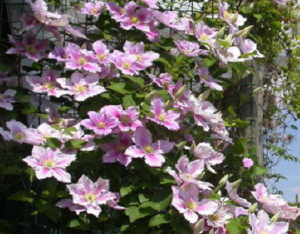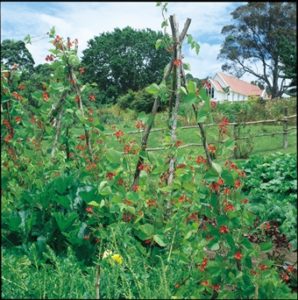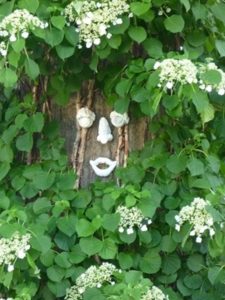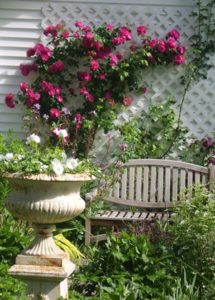Climbing Vines
Climbing vines contribute a valuable third dimension to a garden, an especially valuable component in small spaces or where tall blank walls cry out for décor. In addition to creating an enchanting floral panel, they can also be highly functional, serving as privacy screens, hiding eyesores, or shelter from hot afternoon sun. But before you choose your long-legged beauty, you first need to know how it climbs. This will determine the type of support you need to give it. Is the plant a twiner, scrambler or clinger? Here is an excerpt from my book, The Ultimate Flower Gardener’s Top Ten Lists:

Other plants use tendrils or leaf stalks (petioles) to twirl around slender supports such as chicken wire, netting, string, fishing wire or trellises. Clematis and Morning Glories are in this group. Most climbers fall in the twiners category. (Pictured above – annual vine Scarlet Runner Bean. Pictured – Clematis ‘Hagley Hybrid’)
Clingers: These vines attach themselves to solid surfaces by aerial roots or adhesive discs. Potential supports include large trees, masonry surfaces, wood fences and other rough surfaces. Climbing Hydrangea and Trumpet Vine fall into this group.(Pictured right – Climbing Hydrangea in bloom on my oak tree)
Scramblers or Ramblers: These plants don’t actually climb on their own, they need help being attached with something like twine or string. Climbing roses fall into this category. (Pictured – Canadian Explorer rose ‘William Baffin’ on my trellis)
I loved the article that Gardener’s Supply Company posted on ‘How Plants’ Climb’ that includes a list of examples in each category. Check it out! Another wonderful resource about annual and perennial vines for screening purposes is posted on the University of Minnesota’s extension site.



